Esther Hutfless und Barbara Zach (Hg.): Queering Psychoanalysis. Psychoanalyse 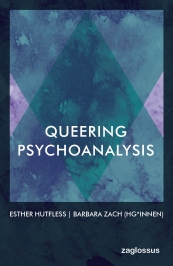 und Queer Theory – Transdisziplinäre Verschränkungen
und Queer Theory – Transdisziplinäre Verschränkungen
Zaglossus, 2017
Aus dem Klappentext:
Die Psychoanalyse stellt eine wichtige Behandlungsmethode im psychotherapeutischen Feld dar und ist eine einflussreiche Stimme in den kultur- und geisteswissenschaftlichen Diskursen unserer Zeit.
Kritische Auseinandersetzungen, insbesondere ausgehend von feministischen und queeren Theorien, werden von der Psychoanalyse kaum aufgegriffen und es gibt innerhalb der psychoanalytischen Theorie und Praxis wenig Bewusstsein für die in ihr wirkenden patriarchalen und heteronormativen Diskurse. Die Psychoanalyse wird daher in den aktuellen Debatten um Geschlechtsidentitäten und sexuelle Orientierungen meist nicht als adäquater theoretischer Zugang wahrgenommen.
Dieser Sammelband möchte einen produktiven Dialog zwischen Psychoanalyse und queeren Theorien im deutschsprachigen Raum initiieren, die unhinterfragten heteronormativen Paradigmen innerhalb der Psychoanalyse dekonstruieren, aber auch wichtige Impulse für das Aufgreifen psychoanalytischer Ansätze in queeren Theorien liefern.
Mit Beiträgen von:
Tim Dean * Teresa de Lauretis * Jack Drescher * Lee Edelman * Antke Engel * Griffin Hansbury * Susann Heenen-Wolff * Esther Hutfless * Jack Pula * Ilka Quindeau * Almut Rudolf-Petersen * Christoph Sulyok * Eve Watson * Anne Worthington * Barbara Zach.
Susann Heenen-Wolff: Gegen die Normativität in der Psychoanalyse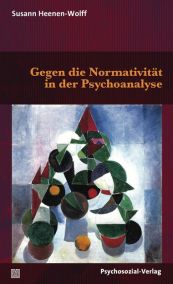
Psychosozial-Verlag, 2018
Aus dem Klappentext:
Die Psychoanalyse ist mit rapiden Veränderungen in den zeitgenössischen Familien- und Beziehungsformen konfrontiert. Eine zu normative Auslegung verschiedener Konzepte von Freud und Lacan verhindert jedoch, dass der faktischen Vielfalt von Liebes- und Familienleben theoretisch und klinisch angemessen Rechnung getragen werden kann. Begriffe wie »der Ödipuskomplex und sein Untergang« oder »reife genitale Sexualität« sind nicht ausreichend, um das psychische Geschehen und seine Interaktionen zu fassen. Susann Heenen-Wolff eröffnet neue, vielversprechende Perspektiven, um zeitgenössische Formen des Sexuallebens zu verstehen.
In ihrem innovativen Plädoyer gegen die Normativität in der Psychoanalyse hinterfragt die Autorin auch die kulturellen, historischen und wissenschaftstheoretischen Bedingungen, im Rahmen derer das psychoanalytische Wissen entstanden ist, sowie dessen Verwaltung in den psychoanalytischen Institutionen. Die engagierten Ausführungen der Autorin machen deutlich, wie wichtig es ist, in Zukunft allzu einfache Schemata zurückzulassen, um den Herausforderungen unserer Lebenswelt gewachsen zu bleiben.
Daniela Finzi and Herman Westerink: Dora, Hysteria and Gender. Reconsidering 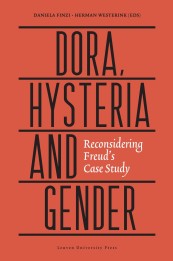 Freud’s Case Study
Freud’s Case Study
Leuven University Press, 2018
Aus dem Klappentext:
Freud’s Dora case and contemporary debates on gender, sexuality and queer theory:
‘Dora’ is one the most important and interesting case studies Sigmund Freud conducted and later described. It constitutes a key text in his oeuvre and finds itself at the crossroads of his studies in hysteria, the theory of sexuality and dream interpretation. The Dora case is both a literary and theoretically ground-breaking text and an account of a ‘failed’ treatment. In Dora, Hysteria and Gender renowned Freud scholars reflect on the Dora case, presenting various innovative and controversial perspectives and elaborating the significance of the text for contemporary debates on gender, sexuality and queer theory.
With contributions by Daniela Finzi, Rachel B. Blass, Beatriz Santos, Philippe Van Haute, Herman Westerink, Jeanne Wolff Bernstein, Ulrike Kadi, Ilka Quindeau, and Esther Hutfless.
Philippe Van Haute and Tomas Geyskens: A Non-Oedipal Psychoanalysis? A Clinical 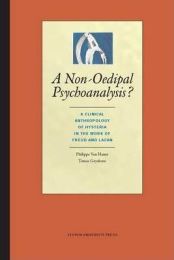 Anthropology of Hysteria in the Works of Freud and Lacan
Anthropology of Hysteria in the Works of Freud and Lacan
Leuven University Press, 2012
This patho-analytic perspective progressively disappears in Freud’s texts after 1905. This book reveals the crucial moments of that development. In doing so, it shows clearly not only that Freud introduced the Oedipus complex much later than is usually assumed, but also that the theory of the Oedipus complex is irreconcilable with the project of a clinical anthropology.
The authors not only examine the philosophical meaning of this thesis in the work of Freud. They also examine its avatars in the texts of Jacques Lacan and show how this project of a patho-analysis of existence inevitably obliges us to formulate a non-oedipal psychoanalytic anthropology.
agmar Herzog: Cold War Freud: Psychoanalysis in an Age of Catastrophes
Cambridge University Press, 2016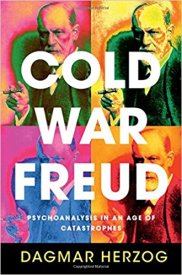
Aus dem Klappentext:
In Cold War Freud Dagmar Herzog uncovers the astonishing array of concepts of human selfhood which circulated across the globe in the aftermath of World War II. Against the backdrop of Nazism and the Holocaust, the sexual revolution, feminism, gay rights, and anticolonial and antiwar activism, she charts the heated battles which raged over Freud’s legacy. From the postwar US to Europe and Latin America, she reveals how competing theories of desire, anxiety, aggression, guilt, trauma and pleasure emerged and were then transformed to serve both conservative and subversive ends in a fundamental rethinking of the very nature of the human self and its motivations. Her findings shed new light on psychoanalysis‘ enduring contribution to the enigma of the relationship between nature and culture, and the ways in which social contexts enter into and shape the innermost recesses of individual psyches.
Fabrice Bourlez: Queer psychanalyse. Clinique mineure et déconstructions du genre
Hermann, 2018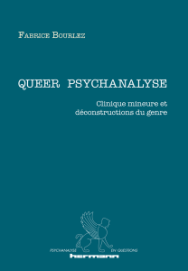
Aus dem Klappentext:
La visée des théories du genre et des idéologies queer est à la fois théorique et éthique : rendre un plus grand nombre de vies vivables. A l’heure du triomphe des thérapies cognitivo-comportementalistes et des transformations profondes de la famille, les psychanalystes peuvent-ils se servir de ces avancées pour réinventer une psychanalyse après l’Œdipe ? Poser cette question, c’est se demander en quoi et pourquoi le travail de Judith Butler, de Teresa De Lauretis, de Gayle Rubin, de Paul B. Preciado et d’une multitude d’autres théoriciens, dé-fait la psychanalyse. C’est s’offrir des pistes concrètes pour revenir sur des formules et des évidences cliniques parfois trop vite tenues pour acquises. C’est resituer la praxis analytique à la croisée de la théorie, de la clinique et du politique. En retour, c’est mettre les concepts des queer face à la tâche impossible qui anime l’analyste, les confronter au réel singulier qui prévaut dans chaque cure. Il ne s’agit donc pas de transformer la pratique en philosophie ou de faire des dé-constructions du genre une clinique, mais de démontrer l’utilité de l’une et l’acuité de l’autre.
Transgender Psychoanalysis: A Lacanian Perspective on Sexual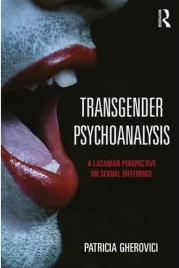 Difference
Difference
Routledge, 2017
Aus dem Klappentext:
„In this strikingly original work, Patricia Gherovici makes a powerful argument for the compatibility of transgenderism and psychoanalysis. Not only that: far from suggesting how psychoanalysts might „treat“ transgender people, Gherovici persuasively proposes that transgenderism might provide new ideas for the clinic. Starting from the premise that the body is not a given, fixed entity, but entails a process of embodiment (a becoming of the body), she argues that psychoanalysis-Lacanian psychoanalysis in particular-is uniquely qualified to support transgenderism’s commitment to new forms of desire.[The frequently presumed „gender trouble“ of transgender people is in fact a universal condition: the impossibility of representing sexuality, an impossibility that implicitly subverts the fixity of all identitarian claims.]With its impeccable scholarship, lucid presentations of complex ideas, and impressive theoretical sophistication, Gherovici’s important work will surely attract a wide audience of readers interested in cultural studies focused on gender and sexuality.“ – Leo Bersani, emeritus professor, UC Berkeley, author of Homos and Is the Rectum a Grave and Other Essays.
„Patricia Gherovici is the psychoanalyst we need now, more so than ever, to show us how and why „sex“ remains a problem, an enigma without adequate solution, even for psychoanalysis. Gherovici navigates the difficult terrain of our transgender cultural moment better than any clinician I’ve read. Her study will be tremendously illuminating for clinical practitioners, as well as for theorists of gender and sexuality.“ – Tim Dean, author of Unlimited Intimacy and Beyond Sexuality
„Psychoanalysis, historically, has not had a good grasp on transgender issues. This is a shame, given that psychoanalytic theory generally offers one of the most robust accounts of subjectivity availabile to us, and that psychoanalytically-infomed clinical practice has great capacity to achieve good therapeutic results for people experiencing psychical suffering. Thankfully that’s changing, in no small part through the brilliant revisionist work of Patricia Gherovici, who demonstrates that Lacan was never as hostile to transsexual clients as some of his followers have made him out to be. In her deft handling, the existence of nonpathological transgender subjects brings a transformative pressure to bear on key psychoanalytic concepts, while demonstrating how psychoanalytic insight can help relieve suffering for transgender people without invalidating their way of being in the world.“ – Susan Stryker, Ph.D., Associate Professor of Gender and Women’s Studies, University of Arizona, and co-editor of TSQ: Transgender Studies Quarterly
Lisa M. Diamond: Sexual Fluidity. Understanding Women’s Love and Desire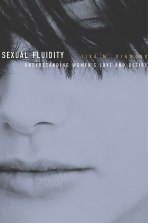
Harvard University Press, 2009
Aus dem Klappentext:
Is love “blind” when it comes to gender? For women, it just might be. This unsettling and original book offers a radical new understanding of the context-dependent nature of female sexuality. Lisa M. Diamond argues that for some women, love and desire are not rigidly heterosexual or homosexual but fluid, changing as women move through the stages of life, various social groups, and, most important, different love relationships. This perspective clashes with traditional views of sexual orientation as a stable and fixed trait. But that view is based on research conducted almost entirely on men. Diamond is the first to study a large group of women over time. She has tracked one hundred women for more than ten years as they have emerged from adolescence into adulthood. She summarizes their experiences and reviews research ranging from the psychology of love to the biology of sex differences. Sexual Fluidity offers moving first-person accounts of women falling in and out of love with men or women at different times in their lives. For some, gender becomes irrelevant: “I fall in love with the person, not the gender,” say some respondents. Sexual Fluidity offers a new understanding of women’s sexuality―and of the central importance of love.
***
Eve Watson and Noreen Giffney (Ed.): Clinical Encounters in Sexuality: 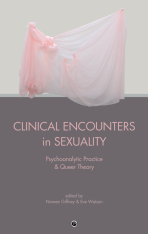 Psychoanalytic Practice and Queer Theory.
Psychoanalytic Practice and Queer Theory.
Punctum, 2017
Clinical Encounters in Sexuality makes an intervention into the fields of clinical psychoanalysis and sexuality studies, in an effort to think about a range of issues relating to sexuality from a clinical psychoanalytic perspective. The editors have chosen queer theory as an interlocutor for the clinical contributors, because it is at the forefront of theoretical considerations of sexuality, as well as being both reliant upon and suspicious of psychoanalysis as a clinical practice and discourse. The book brings together a number of psychoanalytic schools of thought and clinical approaches, which are sometimes at odds with one another and thus tend not to engage in dialogue about divisive theoretical concepts and matters of clinical technique. The volume also stages, for the first time, a sustained clinical psychoanalytic engagement with queer theory. The central questions we present to readers to think about are: What are the discourses of sexuality underpinning psychoanalysis, and how do they impact on clinical practice? In what ways does sexuality get played out for, and between, the psychoanalytic practitioner and the patient? How do social, cultural and historical attitudes towards sexuality impact on the transference and countertransference, consciously and unconsciously? Why is sexuality so prone to reification?
***
Monika Gsell und Eric Winkler (Hg): Heterosexualität und Homosexualität revisited. 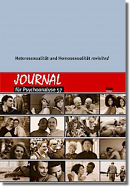 Journal für Psychoanalyse 57.
Journal für Psychoanalyse 57.
Seismo, 2016
Die einzelnen Beiträge sind online verfügbar: Journal für Psychoanalyse 57
***
Patricia Gherovici: Please Select Your Gender: From the Invention of Hysteria to the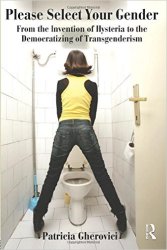 Democratizing of Transgenderism.
Democratizing of Transgenderism.
Routledge, 2010
Reviews:
„‚I’ll have one of those, and – oh! – a pair of those!‘ You can pick out and purchase any number of things, including your own sexual parts – but can you choose your sex? In this fascinating and thoughtful book, Gherovici carefully considers that question by examining ways in which sex and freedom are currently being conjugated in our culture. This profound and important book dares to ask what sex is.“ – Joan Copjec, Ph.D., author, Imagine There’s No Woman.
„Late capitalism tells us that everything in our lives is a matter of choice: Not only are we encouraged to choose new consumer objects, we are invited to perceive our sexual identity as a matter of choice. In this fascinating book, Patricia Gherovici shows how psychoanalysis can help us to understand our troubles with sexual identity. She presents clinical examples showing the complicated relation people have with desire and jouissance when they attempt the impossible task of defining their sexual identity.“ – Renata Salecl, Institute of Criminology, University of Ljubljana, Slovenia.
„Patricia Gherovici hears from her patients a contemporary variant of an age-old question concerning our relationship to our sexuality. Answers to this question do vary, from ‚Anatomy is destiny‘ to the postmodern imperative: ‚Choose!‘ Combining her astute knowledge of Lacanian psychoanalysis with her rich clinical experience treating hysteria, psychosis, and transsexualism, Gherovici demonstrates that these ideologies obfuscate our understanding of particular patients‘ conflicts. This book is a fascinating study of transsexuality because it suggests that a return to the intimate experiences of suffering alone can allow us to go beyond obvious answers.“ – Paul Verhaeghe, University of Ghent, Belgium.
„In this fascinating, insightful, and provocative book, Patricia Gherovici focuses on those who don’t fit easily or comfortably into the social and biological categories used to determine who is a man and who is a woman. By examining the ‚riddle‘ of gender and its asymmetrical relation to biological sex, she points to the mistake of seeing gender as either a biological truth or just a series of learned behaviors and culturally enforced messages. With its invaluable history of intersexuality, bisexuality, and transgenderism as concepts that people use to make sense of their desire and themselves – and its deft use of clinical material – Please Select Your Gender intervenes intelligently and compassionately in several key debates about sex and gender. It should be required reading for those involved in sex-reassignment surgery.“ – Christopher Lane, author, Shyness: How Normal Behavior Became a Sickness.
„This book is as complex and evocative as its title suggests. Drawing from her own psychoanalytic practice, Gherovici provides an intimate account of the psychological dilemmas her patients are facing, arguing for a depathologization of transgendered individuals and for a view of the Other not as an intervening Third, but a witnessing Third who allows for greater freedom of transitional acts. Please Select Your Gender also provides a fascinating read of the history of hysteria, with a particular focus on Lacan’s elaboration of Freud’s ideas about hysteria in terms of his model of sexuation and focus on jouissance. For anyone interested in the ever-evolving history of hysteria and transgender, this book is a compelling ‚must-read.'“ –Jeanne Wolff Bernstein, Psychoanalytic Institute of Northern California, USA.
„In her book Please Select Your Gender: From the Invention of Hysteria to the Democratizing of Transgenderism, Patricia Gherovici draws on historical documents, well-known media accounts, and her own clinical experience to provide her readers with a thorough treatment of transgenderism. She begins the book with an interesting review of the history, both ancient and modern, of gender and sex. She discusses the historical progress of science, understanding of gender- and sex-related issues and disorders, from ancient treatises discussing hysteria to modern transgender theory. Through her specific discussion of transgenderism, Gherovici necessarily enters the larger debate about the foundations and development of gender and sex. Transgenderism and the ability for an individual to change his or her biological sex characteristics to match his or her socioemotional gender characteristics have challenged commonly held definitions of the terms. Please Select Your Gender is not an objective treatment of the available literature but instead a subjective argument for the depathologization of transgenderism and a challenge to change the current pathological approach that psychoanalysis takes toward the issue. Those who are interested in the topic and also well versed in psychoanalytic theory will find that it is an argument she makes capably and successfully.“– Brian K. Ashdown, PsycCritiques.
„Please Select Your Gender stands out as a particularly well-researched book in the field of psychoanalysis. The author leads her readers through a complex web of fascinating chapters on the history of hysteria, sex change operations, and Freud’s famous cases…Gherovici has a gift for translating difficult ideas into common language, and for making them clinically useful and intellectually available to psychoanalysts of all theoretical persuasions…[the book]provides a compassionate, inside account of the conflicts transgendered individuals are facing as they escape the body that is imprisoning them… Beyond a doubt, Gherovici has written a book that goes far beyond the scope of transgenderism, giving readers the rare chance of reading Lacanian thinking at its best and seeing it applied to clinical practice. Moreover, her book should be considered a textbook on the subject of hysteria and thus be added as a laudable addition to the psychoanalytic canon.“ – Jeanne Wolff Bernstein, Division/REVIEW.
***
Alessandra Lemma & Pau. E. Lynch (Ed.): Sexualities: Contemporary Psychoanalytic 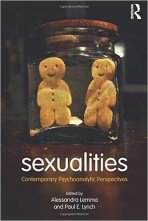 Perspectives.
Perspectives.
Routledge, 2015
Reviews:„The book make a compelling argument for how psychoanalytic conepts such as mirroring and revisiting the Oedipal Complex could help us understand sexual variations (a term preferred by some sexologists to „perversions“), gender, and homosexuality… The current sexual climate requires a reevaluation of theories to explain human sexuality to keep pace with changes in issues such as gay and lesbian rights, sexual dysfunctions, and gender issues. Lemma and Lynch have managed to provide updated and integrative discussions on these issues. Lemma nad Lynch have managed to provide updated and integrative discussions on these issues. The book should be of interest to scholars interested in sexology, as well as to historians of psychology and clinicians.“ – Carlos Escoto, Eastern Connecticut State University, associate editor for Psi Chi Journal of Psychological Research, in PsycCritiques
„In this remarkable new collection of essays, Alessandra Lemma and Paul E. Lynch have provided us with an up-to-the-minute compendium of current psychoanalytic thinking regarding sexualities. Desire, developmental pathways of gender and sexual orientation, prostitution, perversion, sexual excitement, intimacy, and many other themes are considered from various perspectives that are unfailingly enlightening. Psychoanalysis has struggled with this entire area because of our fear of looking at what is in front of our eyes. This extraordinary book helps us see what we may prefer to avoid in ourselves and in others. It deserves a place on the bookshelf of every psychoanalytically-oriented clinician and will surely be used as a textbook for courses in psychoanalytic institutes. – Glen O. Gabbard, MD. – Training and Supervising Analyst at the Center for Psychoanalytic Studies in Houston.
„This book sets a new standard. Contributors portray extraordinary empathy for and rich clinical documentation of the wide range of psychic and behavioral usages of sexuality and gender. They candidly acknowledge wrestling, like Freud, with old feelings — discomfort with some current culturally-contested formulations while being at the forefront of contestation. Several chapters provide an original, creative integration of abstract theories about maternal sexuality with research on attachment, mirroring and mentalization and on-the-ground observations of infantile sexuality. I was grateful for recognition of Stoller’s contribution and for necessary, and too rare, discussions of the relations between sociology, sexology and psychoanalysis.“ – Nancy J Chodorow, PhD. Training and Supervising Analyst, Boston Psychoanalytic Society and Institute.
***
Mary Lynne Ellis & Noreen O’Connor: Questioning Identities: Philosophy in 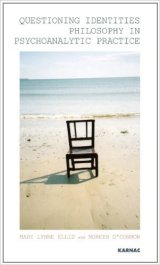 Psychoanalytic Practice.
Psychoanalytic Practice.
Karnac, 2010
Aus dem Klappentext:
Face-to-face with differences in the analytical relationship analysts frequently confront the limitations of their theories. In this new book Mary Lynne Ellis and Noreen O’Connor move to the heart of 21st century intertwining of psychoanalytical and philosophical critical reflections. They highlight how philosophical perspectives on language, embodiment, time, history, and conscious/unconscious experiences can contribute to clinical interpretations of gender, sexuality, race, age, culture, and class. Vital to „Questioning Identities: Philosophy in Psychoanalytic Practice“ is its emphasis on clinical material, and on attentiveness to the uniqueness of individuals‘ articulations of their desires and identities.
***
Tim Dean: Beyond Sexuality.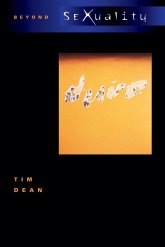
University of Chicago Press, 2000
Aus dem Klappentext:
Combining psychoanalytic emphasis on the unconscious with a respect for the historical variability of sexual identities, this work of queer theory makes the case for vewing erotic desire as fundamentally impersonal. Dean develops a reading of Jacques Lacan that – rather than straightening out this notoriously difficult French psychoanalyst – brings out the queer tensions and productive incoherencies in his account of desire. Dean shows that Lacanian unconscious „deheterosexualizes“ desire, and along the way he reveals how psychoanalytic thinkers as well as queer theorists have failed to exploit the full potential of this conception of desire. The book elaborates this by investigating social fantasies about homosexuality and AIDS, including gay men’s own fantasies about sex and promiscuity, in an attempt to illuminate the challenges facing safe-sex education.
***
Teresa Brennan: Between Feminism and Psychoanalysis.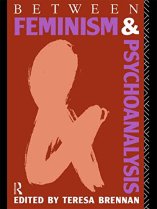
Routledge, 1989
Aus dem Klappentext:
In this landmark collection of original essays, outstanding feminist critics in Britain, France, and the United States present new perspectives on feminism and psychoanalysis, opening out deadlocked debates. The discussion ranges widely, with contributions from feminists identified with different, often opposed views on psychoanalytic criticism. The contributors reassess the history of Lacanian psychoanalysis and feminism, and explore the significance of its institutional context. They write against the received views on ‚French feminism‘ and essentialism. A remarkable restatement of current positions within psychoanalysis and feminism, the volume as a whole will change the terms of existing debates, and make its arguments and concerns more generally accessible.
***
Jack Drescher, Ubaldo Leli (ed.): Transgender Subjectivities: A Clinician’s Guide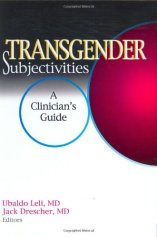
The Haworth Medical Press, 2004
Aus dem Klappentext:
Transgender Subjectivities is a comprehensive guide for understanding the issues and concerns of the emerging transgender phenomenon. As transgender individuals become more “out” in society, the need to understand their concerns, the problems they face, and the resources available to them becomes rapidly more acute. This book offers a diverse yet coherent view of this ever-expanding field. It provides an overview of transsexual manifestations designed to expose therapists as well as the general public to this actively expanding field.
In Transgender Subjectivities, experts in transgender studies examine historical, theoretical, clinical, and subjective aspects of the transgender experience. The contributors include some of the most respected and experienced clinicians and scholars in the field, such as Aaron H. Devor and Anne A. Lawrence, as well as several cutting-edge contemporary theorists, and a number of eloquent transsexual writers—including Dallas Denny and Griffin Hansbury—giving this book a wide and varied perspective.
***
Guy Hocquenghem: Das homosexuelle Verlangen.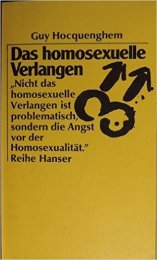
Carl Hanser Verlag, 1974
Guy Hocquenghem war ein französischer Philosoph* und radikaler LGBTIQ Aktivist*. Er trat 1971 der Front Homosexuel d’Action Révolutionnaire bei. Sein Buch Le Désir homosexuel (dt. Das homosexuelle Verlangen) gilt als eines der vergessenen Initialwerke der viel später entstandenen Queer Theory. Hocquenghem beschäftigt sich darin mit der Psychoanalyse aus einer marxistischen Perspektive und kritisiert den normierenden Charakter von psychoanalytischen Diskursen in Bezug auf Homosexualität. Wesentlich beeinflusst ist seine Auseinandersetzung mit der Psychoanalyse auch vom Denken Michel Foucaults und den Werken Deuleze/Guattaris.
***
Gayle Salamon: Assuming a Body: Transgender and Rhetorics of 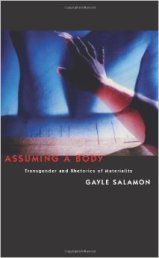 Materiality
Materiality
Columbia University Press, 2010.
Aus dem Klappentext:
We believe we know our bodies intimately–that their material reality is certain and that this certainty leads to an epistemological truth about sex, gender, and identity. By exploring and giving equal weight to transgendered subjectivities, however, Gayle Salamon upends these certainties. Considering questions of transgendered embodiment via phenomenology (Maurice Merleau-Ponty), psychoanalysis (Sigmund Freud and Paul Ferdinand Schilder), and queer theory, Salamon advances an alternative theory of normative and non-normative gender, proving the value and vitality of trans experience for thinking about embodiment.
***
Noreen O’Connor & Joanna Ryan: Wild Desires and Mistaken Identities. Lesbianism 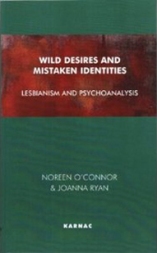 and Psychoanalysis.
and Psychoanalysis.
Karnac Books, London 2003.
Reviews and Endorsments (Karnac):
„Offers the first critical, systematic, and comprehensive survey of psychoanalytic writings on female homosexuality available in English…Remarkable not only for being the first such survey to appear in print, and for its sustained attention to both psychoanalytic theory and clinical practice, but especially for its effort to work through both Freudian psychoanalysis from a lesbian perspective, questioning and yet retaining both categories – psychoanalysis and lesbianism – in tension with each other…Immensely valuable.
– Teresa de Laurentis, Journal of the History of Sexuality
Ranks among the best of recent psychoanalytic work on same-sex object choice…Should prove of great interest to those who are interested primarily in lesbianism and to those who are more concerned with the more general issues of the contours and limitations of psychoanalytic theory and discourse.
– Psychoanalytic Books
[This] exhaustive critical review of psychoanalytic theories about female homosexuality is a necessary reference tool for analytic therapists who want to understand the history and development of psychoanalytic thinking on the subject.
– Clinical Social Work Journal
A truly original venture…The clinical examples are invaluable in widening our understanding.
– Josephine Klein“
***
Leslie Feinberg: Stone Butch Blues. 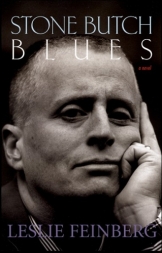
Alyson Books, New York 2003 (dt. Krug & Schadenberg, Berlin 2008)
Aus dem Klappentext:
„Published in 1993, this brave, original novel is considered to be the finest account ever written of the complexities of a transgendered existence. Woman or man? Thats the question that rages like a storm around Jess Goldberg, clouding her life and her identity. Growing up differently gendered in a blue–collar town in the 1950s, coming out as a butch in the bars and factories of the prefeminist 60s, deciding to pass as a man in order to survive when she is left without work or a community in the early 70s. This powerful, provocative and deeply moving novel sees Jess coming full circle, she learns to accept the complexities of being a transgendered person in a world demanding simple explanations: a he-she emerging whole, weathering the turbulence.“
***
Eve Watson: Queering Psychoanalysis/Psychoanalysing Queer.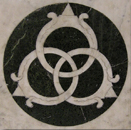
In: Annual Review of Critical Psychology, 7, pp. 114-139.
(Download the text: follow the link)
In the essay „Queering Psychoanalysis/Psychoanalysing Queer“ Psychoanalyst Eve Watsen is dealing with the following questions: „How successful is Lacanian psychoanalysis in queering the field of sexuality? How does Lacanian psychoanalysis elaborate the field of sexuality and the notions of pleasure and desire beyond the confines of ‘self’ and the body. What is queer theory? Does Lacan’s subject of desire meet with the queer project of a radical destabilisation of (hetero)normativity? How successful is queer theory is this respect? What does an encounter between queer theory and Lacanian psychoanalysis generally offer?“ (p. 114 f.)
***
Ilka Quindeau: Verführung und Begehren. Die psychoanalytische Sexualtheorie nach Freud.
Klett-Cotta, Stuttgart 2008
Aus dem Klappentext:
„Die Entwicklung der menschlichen Sexualität folgt keinem angeborenen biologischen Programm, sondern vollzieht sich in einer interpersonalen Beziehung. In der Regel stellt die frühe Eltern-Kind-Beziehung solch einen Ort universeller, unbewusster sexueller Verführung und elementarer Befriedigung dar. Während der bisherige psychoanalytische Diskurs von einer starren Zweiteilung des Geschlechterverhältnisses ausgeht und die Unterschiede zwischen Männern und Frauen betont, entwickelt Ilka Quindeau ein geschlechtsübergreifendes Modell menschlicher Sexualität, das die »männlich«- phallischen und die »weiblich«-rezeptiven Anteile integriert und Raum lässt für die Vielfalt geschlechtlicher Identifizierungen und sexueller Spielarten. Sie zeigt strukturelle Gemeinsamkeiten von Hetero-, Homosexualität und Perversion auf und plädiert für eine allgemein menschliche Sexualität, bei der sich Männer und Frauen weniger voneinander als vielmehr untereinander unterscheiden. Der von Freud postulierte Primat der Genitalität wird dabei ebenso in Frage gestellt wie der kulturelle Primat der Heterosexualität. Schließlich führt die Autorin aus, welche Konsequenzen die neue Sichtweise für die psychotherapeutische Praxis mit sich bringt.“
***
Adria E. Schwartz: Sexual Subjects: Lesbians, Gender and Psychoanalysis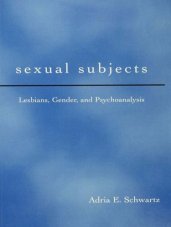 .
.
Routledge, New York 1998
Aus dem Klappentext:
„Sexual Subjects, a psychoanalytic book informed by gender theory, queer theory and feminism, addresses the tensions inherent in writing about lesbians and sexuality in the postmodern age. Adria Schwartz masterfully intertwines clinical anecdotes with engaging theoretical questions that examine the construction of important categories of identity–woman, feminist, mother, lesbian, and homo/hetero/bisexual. Schwartz also addresses specific issues which are problematic but nonetheless meaningful to self-identified lesbians such as roles in gender play, lesbian „bed death,“ and raising non-traditional families. Written from a psychoanalytic and postmodern perspective, this book is a significant contribution to the work done on the conceptualization of lesbian sexuality and identity.“
***
Richard C. Friedman and Jennifer I. Downey: Sexual Orientation & Psychodynamic Psychotherapie.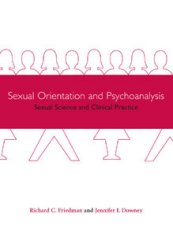
Sexual Science and Clinical Pracitice.
Columbia University Press, New York 2002
Aus dem Klappentext:
„This book bridges psychoanalytic thought and sexual science. It brings sexuality back to the center of psychoanalysis and shows how important it is for students of human sexuality to understand motives that are often irrational and unconscious. The authors present a new perspective about male and female development, emphasizing the ways in which sexual orientation and homophobia appear early in life. The clinical section of the book focuses on the psychodynamics and treatment of homophobia and internalized homophobia.“
***
Ilka Quindeau: Sexualität.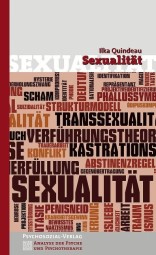
Psychosozial-Verlag, Gießen 2014
Mit „Sexualität“ legt Ilka Quindeau eine versierte und zugleich kompakte Auseinandersetzung mit dem Thema „Sexualität“ in der Psychoanalyse vor. Ausgehend von Freuds „Drei Abhandlungen zur Sexualtheorie“ und Jean Laplanches „allgemeiner Verführungstheorie“ wird das Thema zusammen mit aktuellen wissenschaftlichen und gesellschaftlichen Entwicklungen beleuchtet. Ilka Quindeau stellt Konzepte aus der Psychoanalyse vor, anhand derer es möglich wird Sexualität jenseits von biologistischen, statischen oder heteronormativen Ansätzen zu denken.
Einige Fragen, die im Buch aufgeworfen und behandelt werden: Gibt es einen Unterschied zwischen weiblicher und männlicher Sexualität und ist eine derartige Differenzierung aus psychoanlytischer Perspektive sinnvoll? Wie kann die Entwicklung zu Hetereo- und Homosexualität gedacht werden ohne letztere zu pathologisieren? Wie kann Sexualität als beständiger Entwicklungsprozess begriffen werden? Wie sind „sexuelle Störungen“ aus heutiger Perspektive zu verstehen? Auf welche Weise kann das Thema Sexualität in Analysen oder Therapien thematisiert werden?
EsHu
***
Marlen Bidwell-Steiner, Anna Babka (Hg.): Obskure Differenzen: Psychoanalyse und Gender Studies.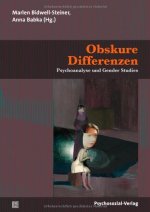
Psychosozial-Verlag, Gießen 2013
Aus dem Klappentext:
„Gegenwärtig werden Geschlechtsidentitäten in vielen Kulturen als fragil und wandelbar erlebt. Um den damit verbundenen individuellen und kollektiven Erfahrungen zwischen Angst und Neugier besser begegnen zu können, ist eine Zusammenführung von Psychoanalyse und Gender Studies naheliegend und notwendig. Beide Disziplinen haben seit ihren Anfängen einen prekären institutionellen Status inne. Ihre genuine Hinwendung zu Fragen der geschlechtlichen Identifizierung und der gemeinsame Anspruch auf ein Ineinandergreifen von Theorie und Praxis implizieren vielfältige Anschlussmöglichkeiten. Doch trotz innovativer theoretischer Ansätze innerhalb beider Fachrichtungen ist es nicht leicht, diese ineinander zu überführen und produktiv zu machen. Durch ihre Expertise in beiden Forschungsrichtungen gelingt es den BeiträgerInnen, ein produktives Spannungsverhältnis zwischen der psychoanalytischen Praxis und den Ansätzen der Gender Studies herzustellen und die wechselseitige Rezeption zu stärken. Zugleich werden die obskuren Differenzen beleuchtet und verborgene Parallelen herausgearbeitet. Mit Beiträgen von Mit Beiträgen von Anna Babka, Marlen Bidwell-Steiner, Beate Hofstadler, Ortrun Hopf, Ulrike Kadi, Brigitta Keintzel, Eva Laquièze-Waniek, Wolfgang Müller-Funk, Susanne Lummerding, Juliet Mitchell, Alice Pechriggl, Ilka Quindeau und Alenka Zupančič.“
***
Angela Mauss-Hanke (Hg.): Internationale Psychoanalyse Band 8. Weiblichkeit und 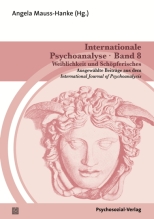 Schöpferisches.
Schöpferisches.
Psychosozial-Verlag, Gießen 2013
Den Schwerpunkt dieser Auswahl aus dem International Journal of Psychoanalysis der Jahre 2011 bis 2012 bilden Aufsätze, die unter dem Thema „Weiblichkeit und Schöpferisches“ versammelt werden. Und obwohl der Titel auf den ersten Blick unter den Verdacht eines esoterischen Biologismus/Materialismus gerät, lohnt sich die Lektüre für alle psychoanalytisch interessierten Leser_innen, denn sie gibt einen Einblick in aktuelle Konzeptionen der Psychoanalyse, die weder in den psychoanalytischen Ausbildungen noch in ihrer Mainstream-Rezeption Platz finden. Insbesondere das Verständnis des weiblichen Exhibitionismus als Freude an der Weiblichkeit (für mich erweiterbar: an der eigenen Geschlechtlichkeit) sowie als Ausdruck von homoerotischem Begehren und die damit einhergehende Ergänzung des defizitären Konzepts des Penisneides „der Frau“ als Sicht auf die „weibliche“ Psyche, erfreut Hirn und Herz. Nancy Kulish und Deanna Holzman machen aus dem Ödipus-Komplex jenen der Persephone und verhelfen damit dem triadischen Entwicklungsschritt auch zu einem gleichgeschlechtlich begehrenden Aspekt. Einen Einblick in die Kompatibilität von psychoanalytischem Denken und postmodernem Geschlechterverständnis gibt Nicolas Ray, der anhand Peter Greenaways Film „The Pillow Book“ und Jean Laplanches allgemeiner Verführungstheorie aus der Passivität als einer spezifisch weiblichen Zuschreibung eine für alle Menschen macht – egal welchen Geschlechts.
BaZa
***
Thomas Domenici, Ronnie C. Lesser (Hg.): Disorienting Sexuality. Psychoanalytic Reappraisals of 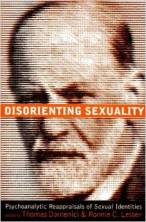 Sexual Identities.
Sexual Identities.
Roudledge, New York 1995
Aus dem Klappentext:
„Disorienting Sexuality exposes the biases against gay men and lesbians in psychoanalytic theory and practice. In the introduction, Domenici and Lesser draw a brief history of anti-homosexual sentiment in psychoanalysis. The book then moves into essays written by lesbian and gay psychoanalysts seeking to have a voice in the reshaping of psychoanalytic theories of sexuality. The second section is devoted to presenting different theoretical perspectives for understanding both homosexuality and heterosexuality. Disorienting Sexuality concludes with the personal narratives of gay and lesbian psychoanalysts.“
***
Judith Butler: Körper von Gewicht.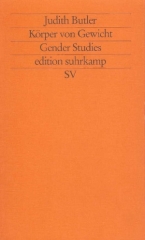
Suhrkamp Verlag, Frankfurt/M. 1997
In „Körper von Gewicht“ unterzieht Judith Butler den Materialitäts- und damit Körperbegriff einer philosophischen Relektüre. Sie antwortet mit diesem Buch auf die deutschsprachige Rezeption ihres Buches „Gender-Trouble“ und macht deutlich, dass es in ihrem Denken von Geschlecht und Materie nicht allein um die durch Sprache hervorgebrachten Körper und Geschlechter geht, sondern dass Materie über eine eigene Widerständigkeit verfügt, die zugleich aber auch nicht als metaphysisches Konzept gelesen werden kann. Das Buch unterstreicht, dass Körper, Sprache, Geschlecht, Materie und deren Konstitution in einem weitaus komplexeren Verhältnis zueinander stehen.
Neben der Auseinandersetzung u. a. mit Irigaray, Aristoteles und der Entwicklung von „queer“ als politischem Konzept, gibt es auch eine Auseinandersetzung mit der Psychoanalyse – Butler schlägt vor, ein positives Konzept vom lesbischen Phallus zu denken.
EsHu
***
Barbara Gissrau: Die Sehnsucht der Frau nach der Frau.
Books on Demand, Neuauflage 2005
Aus dem Klappentext:
„Die Psychoanalytikerin Barbara Gissrau wirft in diesem Buch einen neuen Blick auf die weibliche psychosexuelle Entwicklung. Sie geht der Sozialisation zur Heterosexualität und zur Homosexualität nach. Dabei bricht sie das jahrhunderte alte Vorurteil auf, daß Homosexualität eine Krankheit oder eine Störung sei, die „geheilt“ werden müsse. Dieses Vorurteil hatten bis vor kurzem noch alle psychotherapeutische Schulen gepflegt, anstatt es zu hinterfragen. Barbara Gissrau entwickelte aufgrund von 36 Tiefeninterviews mit hetero- und homosexuellen Frauen als erste im deutschsprachigen Raum ein plausible Theorie weiblicher Lebensstile, in der jede Form der freiwilligen gegenseitigen Liebe willkommen ist. Sie entdeckte dabei, daß wir weder hetero- noch homo- noch bisexuell sind, sondern mit einer multierotischen Anlage auf die Welt kommen. Dadurch können wir uns gundsätzlich in alles aus unserer Umgebung verlieben, also in Männer, Frauen, Blumen, Tiere, Steine, Autos, einfach alles, auf das wir mit interessiertem, vorurteilsfreiem Blick schauen.“
***
Tim Dean, Cristopher Lane (Hg.): Homosexuality and Psychoanalysis.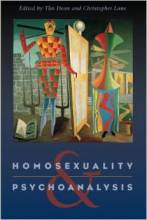
University of Chicago Press, Chicago 2000
Aus dem Klappentext:
„Why has homosexuality always fascinated and vexed psychoanalysis? This groundbreaking collection of original essays reconsiders the troubled relationship between same-sex desire and psychoanalysis, assessing homosexuality’s status in psychoanalytic theory and practice, as well as the value of psychoanalytic ideas for queer theory. The contributors, each distinguished clinicians and specialists, reexamine works by Freud, Klein, Reich, Lacan, Laplanche, and their feminist and queer revisionists. Sharing a commitment to conscious and unconscious forms of homosexual desire, they offer new perspectives on pleasure, perversion, fetishism, disgust, psychosis, homophobia, AIDS, otherness, and love. Including two previously untranslated essays by Michel Foucault, Homosexuality and Psychoanalysis will interest cultural theorists, psychoanalysts, and anyone concerned with the fate of sexuality in our time.“
***
Theresa de Lauretis: The Practice of Love. Lesbian Sexuality and Perverse Desire.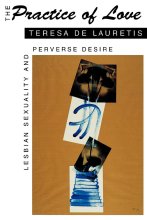
Indiana University Press, Bloomington 1994
In einer feministischen Relektüre von Freud über Lacan und Laplanche hinterfragt de Lauretis klassische psychoanalytische Narrative zu weiblicher Homosexualität und entwirft neue Ansätze zum Konzept der Perversion und des lesbischen Begehrens, wobei der Fetisch im Zentrum der Auseinandersetzung steht.
EsHu
***
Juliet Mitchell: Psychoanalysis and Feminism.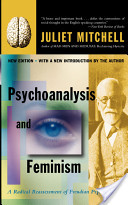
Penguin Books, New York 200o (first published: 1974)
Aus dem Klappentext:
„In 1974, at the height of the women’s movement, Juliet Mitchell shocked her fellow feminists by challenging the entrenched belief that Freud was the enemy. She argued that a rejection of psychoanalysis as bourgeois and patriarchal was fatal for feminism. However it may have been used, she pointed out, psychoanalysis is not a recommendation for a patriarchal society, but rather an analysis of one. „If we are interested in understanding and challenging the oppression of women,“ she says, „we cannot afford to neglect psychoanalysis.“ In an introduction written specially for this reissue, Mitchell reflects on the changing relationship between these two major influences on twentieth-century thought. Original and provocative, Psychoanalysis and Feminism remains an essential component of the feminist canon.“
***
Luce Irigaray: Das Geschlecht das nicht eins ist.
Merve Verlag, Berlin 1979
„Das Geschlecht das nicht eins ist“ besteht aus mehreren Essays und Interviews. Insbesondere ans Herz legen wir den Text „Wenn unsere Lippen sich sprechen“. Hier entwirft Irigaray mit der Metonymie der Lippen ein komplexes und vielgestaltiges, subversives und radikales Gegenkonzept zum Penis/Phallus.
EsHu
Du muss angemeldet sein, um einen Kommentar zu veröffentlichen.